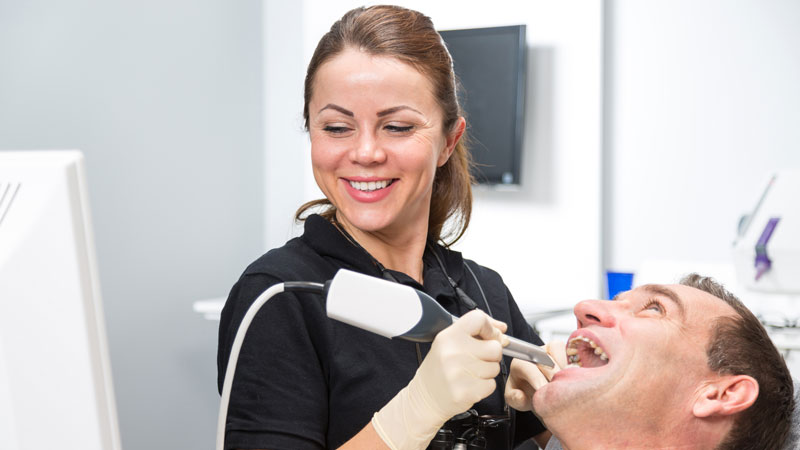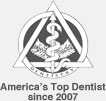Improving Dental Care with Intra-Oral Cameras

At Pacific Northwest Prosthodontics, it would be hard for us to imagine practicing dentistry without intra-oral camera technologies. The value of the intra-oral camera should not be underestimated. We use this device on a regular basis not only to provide better care, but also to educate patients about treatments, as well as to ensure that insurance companies receive images with claims that will increase the odds that procedures will be reimbursed.
The quality of the images that can be produced using intraoral cameras have improved dramatically over the past few years and the design of these devices has been slowly slenderized and made more ergonomic such that images can be captured easily with just one click. Intraoral cameras usually have cords that can be plugged into the USB port on a computer and these days, intraoral imagery is able to work with radiography software products. Dentists who are skilled at using these devices have a definite advantage in the dental industry.
As with many computer application programs, the intraoral camera system that we use at Washington State Prosthodontics is compatible with our office software system which means that diagnostics are streamlined. The super clear imagery along with the magnifying abilities of the intraoral camera allows us to show our patients exactly what we see when we look inside the mouth. Prior to the development of these imaging technologies, it was often difficult or impossible to demonstrate the oral environment inside patients mouths to the patients themselves. But a large-screen image of bleeding gums and obvious inflammatory issues or the presence of calculus can be pretty compelling for those patients who are interested in their oral health.
A Picture Is Worth A Thousand Words, As They Say
Because our Pacific Northwest Prosthodontics patients are able to see what we see and understand their unique dental situation through a little education, most of our patients can understand their condition and most are willing to comply with our recommended course of treatment. The ability to show and tell has vastly improved our ability to provide dental care to our patients.
Seeing Is Believing
The increased use of intraoral imaging in the dental industry has done wonders for patient compliance in terms of treatment recommendations. Speaking from experience with our own patients at Pacific Northwest Prosthodontics, we can say that without compelling images to show to the patient, most patients fail to understand the true magnitude of their problems. Because treatment acceptance and compliance has improved along with the development of these technologies, our patient care paradigm has also improved. Our patients have become significantly more savvy regarding their dental care which means that their quality of life is generally improved as a result.
But while our ability to educate patients is our top priority, it’s also important to note that intra-oral cameras have changed the way that we do business with dental insurance companies as well. This is an important consideration for patients who wish to only have treatments that dental insurance will pay for. One of the most important gestures we can make to get preauthorization for treatment from an insurance provider is to attach intraoral images to the claim. Radiographs often can’t provide the same level of detail or the compelling evidence necessary for treatment. The patient may not feel any pain, but he or she may be open to the idea of treatment as long as insurance will pay for it. Intra-oral images can be used to get the necessary pre-authorization for treatment in situations such as these. In the long run, the patient is likely to avoid additional pain and the high cost of a major dental problem as a result of doing the preventative procedure before it becomes a real issue.
Dental Disease Progression
Dentists see hundreds of patients and it can be challenging to remember each patient’s specific issues from one appointment to the next, but intra-oral cameras can help us quickly recollect what’s going on. At Pacific Northwest Prosthodontics, we can chart the progression of disease or the development of dental problems by simply glancing at the intra-oral images that have been taken over time.
At each visit, the dentist or hygienist can check the specific areas of the patient’s mouth that have already been identified as problematic and see high-definition imagery of the situation at the patient’s last visit. The ability to compare the patient’s current situation with the photos that were taken in the past is incredibly valuable especially when we’re looking at problems related to tooth decay, lesions in the soft tissues, and other conditions.
New Patient Intake Technologies
When new patients arrive at our clinic, we take special time during the visit to gather initial records, take radiographs, chart the status of periodontal health, and to take intraoral images of existing dental restorations along with areas of the mouth that look like they could pose problems in the future (cavities, gingivitis, failing restorations, etc.). This protocol allows us to discuss patient concerns and demonstrate, using high-quality photos, what treatments are necessary and what patients can do to care for their teeth in between dental visits.
Patient Empowerment
Hygienists who are able to see intraoral images of the patient’s dental condition are significantly empowered to point out potential issues even before the dentist enters the room. Intraoral imaging, as a result, has the effect of creating cohesion among the dental staff members. Indeed, the patient is even on-boarded onto the dental team because the ability to visualize the dental issues that exist makes it easy to understand the need for treatment and patients tend to make better decisions about their dental care as a result. Everyone ends up working together more fluently as a result of the images. Question and answer sessions are more productive, and patients tend to adhere to treatment requests between visits.
As a result of this simple tool, patients, dentists, and hygienists are able to work together as a team and the overall impact is that patient care is dramatically improved. It doesn’t matter whether the patient visited the clinic in order to treat an issue related to pain or cosmetic concerns. Intraoral imaging is, without a doubt, one of the most valuable tools currently in use in modern dentistry.

 (425) 549-4649
(425) 549-4649









